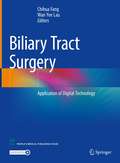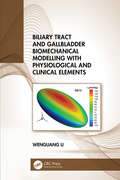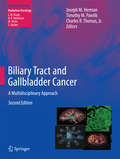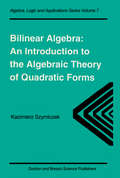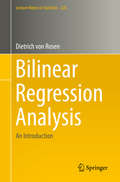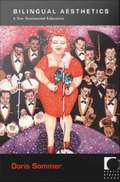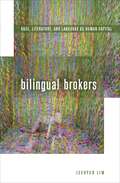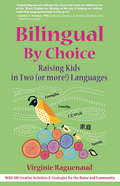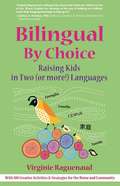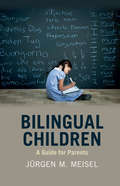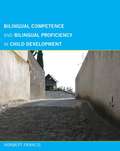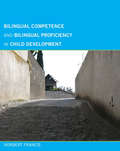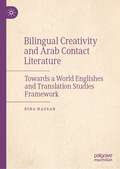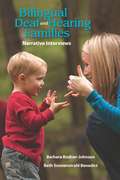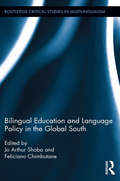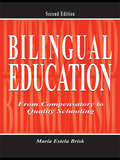- Table View
- List View
Biliary Tract Surgery: Application of Digital Technology
by Chihua Fang Wan Yee LauThis book presents the latest application of digital medical imaging technology in biliary tract surgery, including three-dimensional visualization preoperative evaluation, preoperative surgical planning, and simulated biliary surgery. Digital surgical diagnosis and treatment of cholecystolithisasis, bile duct stones, hepatolithiasis, gallbladder cancer, and bile duct cancer is described in details with more than 900 illustrations. Written by experts with wealthy of clinical experience, it will be a useful reference for general surgeons, as well as practitioners in related disciplines.
Biliary Tract and Gallbladder Biomechanical Modelling with Physiological and Clinical Elements
by Wenguang LiGallstone and other diseases of the biliary tract affect more than around 20% of the adult population. The complications of gallstones, acute pancreatitis and obstructive jaundice, can be lethal. This is the first book to systematically treat biliary tract and gallbladder modelling with physiological and clinical information in a biomechanical context. The book provides readers with detailed biomechanical modelling procedures for the biliary tract and gallbladder based on physiological information, clinical observations and experimental data and with the results properly interpreted in terms of clinical diagnosis and with biomechanical mechanisms for biliary diseases. The text can be used as a reference book for university undergraduates, postgraduates and professional researchers in applied mathematics, biomechanics, biomechanical engineering and biomedical engineering, as well as related surgeons.
Biliary Tract and Gallbladder Cancer: A Multidisciplinary Approach (Medical Radiology)
by Timothy M. Pawlik Charles R. Thomas Joseph M. HermanThe second edition of this book is intended as a definitive text on biliary tract and gallbladder cancers. Specifically, it will serve as a single-source reference on the current knowledge base for the multidisciplinary management of such cancers and thus covers epidemiological, surgical, radiotherapy, and chemotherapy approaches. A key feature is the demonstration of the impact of cutting-edge technical knowledge on treatment; for example, interventional radiology techniques, novel surgical approaches, and image-guided radiation therapy are all extensively discussed. Diagnosis is also considered in detail, with coverage of novel serum biomarkers, pathologic staging, molecular profiling, and the full range of current and emerging imaging strategies. This book will be an invaluable source of information on new techniques for experienced practitioners, yet is sufficiently concise to offer an introduction to the field for students and community practitioners.
Bilinear Algebra: An Introduction to the Algebraic Theory of Quadratic Forms (Algebra, Logic And Applications Ser. #Vol. 7)
by Kazimierz SzymiczekGiving an easily accessible elementary introduction to the algebraic theory of quadratic forms, this book covers both Witt's theory and Pfister's theory of quadratic forms. Leading topics include the geometry of bilinear spaces, classification of bilinear spaces up to isometry depending on the ground field, formally real fields, Pfister forms, the Witt ring of an arbitrary field (characteristic two included), prime ideals of the Witt ring, Brauer group of a field, Hasse and Witt invariants of quadratic forms, and equivalence of fields with respect to quadratic forms. Problem sections are included at the end of each chapter. There are two appendices: the first gives a treatment of Hasse and Witt invariants in the language of Steinberg symbols, and the second contains some more advanced problems in 10 groups, including the u-invariant, reduced and stable Witt rings, and Witt equivalence of fields.
Bilinear Maps and Tensor Products in Operator Theory (Universitext)
by Carlos S. KubruslyThis text covers a first course in bilinear maps and tensor products intending to bring the reader from the beginning of functional analysis to the frontiers of exploration with tensor products. Tensor products, particularly in infinite-dimensional normed spaces, are heavily based on bilinear maps. The author brings these topics together by using bilinear maps as an auxiliary, yet fundamental, tool for accomplishing a consistent, useful, and straightforward theory of tensor products. The author’s usual clear, friendly, and meticulously prepared exposition presents the material in ways that are designed to make grasping concepts easier and simpler. The approach to the subject is uniquely presented from an operator theoretic view. An introductory course in functional analysis is assumed. In order to keep the prerequisites as modest as possible, there are two introductory chapters, one on linear spaces (Chapter 1) and another on normed spaces (Chapter 5), summarizing the background material required for a thorough understanding. The reader who has worked through this text will be well prepared to approach more advanced texts and additional literature on the subject.The book brings the theory of tensor products on Banach spaces to the edges of Grothendieck's theory, and changes the target towards tensor products of bounded linear operators. Both Hilbert-space and Banach-space operator theory are considered and compared from the point of view of tensor products. This is done from the first principles of functional analysis up to current research topics, with complete and detailed proofs. The first four chapters deal with the algebraic theory of linear spaces, providing various representations of the algebraic tensor product defined in an axiomatic way. Chapters 5 and 6 give the necessary background concerning normed spaces and bounded bilinear mappings. Chapter 7 is devoted to the study of reasonable crossnorms on tensor product spaces, discussing in detail the important extreme realizations of injective and projective tensor products. In Chapter 8 uniform crossnorms are introduced in which the tensor products of operators are bounded; special attention is paid to the finitely generated situation. The concluding Chapter 9 is devoted to the study of the Hilbert space setting and the spectral properties of the tensor products of operators. Each chapter ends with a section containing “Additional Propositions" and suggested readings for further studies.
Bilinear Regression Analysis: An Introduction (Lecture Notes In Statistics Ser. #220)
by Dietrich Von RosenThis book expands on the classical statistical multivariate analysis theory by focusing on bilinear regression models, a class of models comprising the classical growth curve model and its extensions. In order to analyze the bilinear regression models in an interpretable way, concepts from linear models are extended and applied to tensor spaces. Further, the book considers decompositions of tensor products into natural subspaces, and addresses maximum likelihood estimation, residual analysis, influential observation analysis and testing hypotheses, where properties of estimators such as moments, asymptotic distributions or approximations of distributions are also studied. Throughout the text, examples and several analyzed data sets illustrate the different approaches, and fresh insights into classical multivariate analysis are provided. This monograph is of interest to researchers and Ph.D. students in mathematical statistics, signal processing and other fields where statistical multivariate analysis is utilized. It can also be used as a text for second graduate-level courses on multivariate analysis.
Bilingual Aesthetics: A New Sentimental Education
by Doris SommerKnowing a second language entails some unease; it requires a willingness to make mistakes and work through misunderstandings. The renowned literary scholar Doris Sommer argues that feeling funny is good for you, and for society. In Bilingual Aesthetics Sommer invites readers to make mischief with meaning, to play games with language, and to allow errors to stimulate new ways of thinking. Today's global world has outgrown any one-to-one correlation between a people and a language; liberal democracies can either encourage difference or stifle it through exclusionary policies. Bilingual Aesthetics is Sommer's passionate call for citizens and officials to cultivate difference and to realize that the precarious points of contact resulting from mismatches between languages, codes, and cultures are the lifeblood of democracy, as well as the stimulus for aesthetics and philosophy. Sommer encourages readers to entertain the creative possibilities inherent in multilingualism. With her characteristic wit and love of language, she focuses on humor--particularly bilingual jokes--as the place where tensions between and within cultures are played out. She draws on thinking about humor and language by a range of philosophers and others, including Sigmund Freud, Immanuel Kant, Ludwig Wittgenstein, Hannah Arendt, and Mikhail Bakhtin. In declaring the merits of allowing for crossed signals, Sommer sends a clear message: Making room for more than one language is about value added, not about remediation. It is an expression of love for a contingent and changing world.
Bilingual Being
by Kathleen Saint-OngeWritten by a survivor of childhood abuse, this moving memoir traces the influence of the author's mother tongue in the formation of her identity, and the role her second language played in providing a psychological sanctuary. Kathleen Saint-Onge reflects on the ambiguities of growing up in a primarily French household while attending English schools as she richly recounts the emotional gains and losses of a life lived in two languages. A testament to the power of language in determining feelings of belonging or alienation, Bilingual Being also presents a portrait of the 1960s in Quebec and the changing role of the Catholic Church. Depicting with warmth and humour her own developing independence gained at school, Saint-Onge reveals the tensions between the social world of her evolving English and her deep roots in French-speaking Quebec City. It is an exploration of hope where language provides an escape from traumatic memories and a chance to reconstruct a secure sense of self. Bilingual Being is a superbly crafted autobiography that seamlessly moves from the remembrance of abuse to observations of living bilingualism and the gradual unfolding of recovery in adulthood. It is a compelling, beautiful, and brave narrative that tells a wider story about human resilience and the impact of language in creating new possibilities for life.
Bilingual Being: My Life as a Hyphen
by Kathleen Saint-OngeWritten by a survivor of childhood abuse, this moving memoir traces the influence of the author's mother tongue in the formation of her identity, and the role her second language played in providing a psychological sanctuary. Kathleen Saint-Onge reflects on the ambiguities of growing up in a primarily French household while attending English schools as she richly recounts the emotional gains and losses of a life lived in two languages. A testament to the power of language in determining feelings of belonging or alienation, Bilingual Being also presents a portrait of the 1960s in Quebec and the changing role of the Catholic Church. Depicting with warmth and humour her own developing independence gained at school, Saint-Onge reveals the tensions between the social world of her evolving English and her deep roots in French-speaking Quebec City. It is an exploration of hope where language provides an escape from traumatic memories and a chance to reconstruct a secure sense of self. Bilingual Being is a superbly crafted autobiography that seamlessly moves from the remembrance of abuse to observations of living bilingualism and the gradual unfolding of recovery in adulthood. It is a compelling, beautiful, and brave narrative that tells a wider story about human resilience and the impact of language in creating new possibilities for life.
Bilingual Brokers: Race, Literature, and Language as Human Capital
by Jeehyun LimReading Asian American and Latino literature, Bilingual Brokers traces the shift in attitudes toward bilingualism in postwar America from the focus on cultural assimilation to that of resource management. Interweaving the social significance of language as human capital and the literary significance of English as the language of cultural capital, Jeehyun Lim examines the dual meaning of bilingualism as liability and asset in relation to anxieties surrounding “new” immigration and globalization.Using the work of Younghill Kang, Carlos Bulosan, Américo Paredes, Maxine Hong Kingston, Richard Rodriguez, Chang-rae Lee, Julia Alvarez, and Ha Jin as examples, Lim reveals how bilingual personhood illustrates a regime of flexible inclusion where an economic calculus of one’s value crystallizes at the intersections of language and racial difference. By pointing to the nexus of race, capital, and language as the focal point of postwar negotiations of difference and inclusion, Bilingual Brokers probes the faultlines of postwar liberalism in conceptualizing and articulating who is and is not considered to be an American.
Bilingual By Choice: Raising Kids in Two (or more!) Languages
by Virginie RaguenaudMore and more people—hundreds of millions around the world—are living in bilingual homes. In the U.S. alone, more than 54 million people over the age of 5 speak a language other than English at home. Yet once children enter school, the pull toward one language becomes stronger and maintaining the bilingual advantage requires a serious family commitment—a bilingual choice. The good news is it's worth it. Research shows that bilingual children are known to have more social, cultural and economic opportunities as they grow to adulthood and that learning a second language from birth can even result in protection against Alzheimer's later in life. Bilingual By Choice provides families with specific activities, games and insights that will show them how to not only teach their kids more than one language but also to help their kids retain and develop those language skills. For parents, educators, immigrants and expatriates, Bilingual by Choice deals directly with the obstacles to sustaining a second language, including unsupportive relatives, issues at school, frequent relocations and discrimination, countering each one with the author's firsthand experience with both sides of the growing-up-bilingual journey, as a child and as a parent. Commit to the choice, and help your children become bilingual—for life.
Bilingual By Choice: The Family Guide For Raising Kids In Two (or More!) Languages
by Virginie RaguenaudMore and more people-hundreds of millions around the world-are living in bilingual homes. In the U.S. alone, more than 54 million people over the age of 5 speak a language other than English at home. Yet once children enter school, the pull toward one language becomes stronger and maintaining the bilingual advantage requires a serious family commitment-a bilingual choice. The good news is it's worth it. Research shows that bilingual children are known to have more social, cultural and economic opportunities as they grow to adulthood and that learning a second language from birth can even result in protection against Alzheimer's later in life. Bilingual By Choice provides families with specific activities, games and insights that will show them how to not only teach their kids more than one language but also to help their kids retain and develop those language skills. For parents, educators, immigrants and expatriates, Bilingual by Choice deals directly with the obstacles to sustaining a second language, including unsupportive relatives, issues at school, frequent relocations and discrimination, countering each one with the author's firsthand experience with both sides of the growing-up-bilingual journey, as a child and as a parent. Commit to the choice, and help your children become bilingual-for life.
Bilingual Children: A Parents' Guide
by Jürgen MeiselAre you raising your child bilingually, or planning to do so in the future, but are unsure how to proceed? Using a question-and-answer format, this practical and reassuring guide will enable readers to make informed decisions about how to raise their child with two or more languages. To grow up bilingually is a necessity or an opportunity for more children today than ever before. However, parents are frequently uncertain about what to do, or even fear that they may be putting their child's development at risk. Disentangling fact from myth, it shows that a child can acquire more than one 'first' language simultaneously and that one language need not have negative effects on the other. Each chapter is devoted to a question typically asked by parents in counselling sessions, followed by a concise answer, summaries of the evidence and practical tips.
Bilingual Community Education and Multilingualism
by Zeena Zakharia Ofelia GarcíaThis book explores bilingual community education, specifically the educational spaces shaped and organized by American ethnolinguistic communities for their children in the multilingual city of New York. Employing a rich variety of case studies which highlight the importance of the ethnolinguistic community in bilingual education, this collection examines the various structures that these communities use to educate their children as bilingual Americans. In doing so, it highlights the efforts and activism of these communities and what bilingual community education really means in today's globalized world. The volume offers new understandings of heritage language education, bilingual education, and speech communities for bilingual Americans in the 21st century.
Bilingual Competence and Bilingual Proficiency in Child Development
by Norbert FrancisWhen two or more languages are part of a child's world, we are presented with a rich opportunity to learn something about language in general and about how the mind works. In this book, Norbert Francis examines the development of bilingual proficiency and the different kinds of competence that come together in making up its component parts. In particular, he explores problems of language ability when children use two languages for tasks related to schooling, especially in learning how to read and write. He considers both broader research issues and findings from an ongoing investigation of child bilingualism in an indigenous language--speaking community in Mexico. This special sociolinguistic context allows for a unique perspective on some of the central themes of bilingualism research today, including the distinction between competence and proficiency, modularity, and the Poverty of Stimulus problem. Francis proposes that competence (knowledge) should be considered as an integral component of proficiency (ability) rather than something separate and apart, arguing that this approach allows for a more inclusive assessment of research findings from diverse fields of study. The bilingual indigenous language project illustrates how the concepts of modularity and the competence-proficiency distinction in particular might be applied to problems of language learning and literacy. Few investigations of indigenous language and culture approach bilingual research problems from a cognitive science perspective. By suggesting connections to broader cognitive and linguistic issues, Francis points the way to further research along these lines.
Bilingual Competence and Bilingual Proficiency in Child Development
by Norbert FrancisA study of first and second language development in an indigenous community with implications for broader linguistic and cognitive issues.When two or more languages are part of a child's world, we are presented with a rich opportunity to learn something about language in general and about how the mind works. In this book, Norbert Francis examines the development of bilingual proficiency and the different kinds of competence that come together in making up its component parts. In particular, he explores problems of language ability when children use two languages for tasks related to schooling, especially in learning how to read and write. He considers both broader research issues and findings from an ongoing investigation of child bilingualism in an indigenous language–speaking community in Mexico. This special sociolinguistic context allows for a unique perspective on some of the central themes of bilingualism research today, including the distinction between competence and proficiency, modularity, and the Poverty of Stimulus problem.Francis proposes that competence (knowledge) should be considered as an integral component of proficiency (ability) rather than something separate and apart, arguing that this approach allows for a more inclusive assessment of research findings from diverse fields of study. The bilingual indigenous language project illustrates how the concepts of modularity and the competence-proficiency distinction in particular might be applied to problems of language learning and literacy.Few investigations of indigenous language and culture approach bilingual research problems from a cognitive science perspective. By suggesting connections to broader cognitive and linguistic issues, Francis points the way to further research along these lines.
Bilingual Creativity and Arab Contact Literature: Towards a World Englishes and Translation Studies Framework
by Dina HassanThis book adopts an integrated approach to the study of contact literature through collaboration between theories of World Englishes and translation studies. The author proposes an interactive framework that integrates linguistic and cultural perspectives, through the analysis of selected Anglo-Arab and Arab-American contact literary texts: Samia Serageldine’s The Cairo House (2000), Leila Ahmed’s A Border Passage (1999), Leila Aboulela’s The Translator (1999), Ahdaf Soueif’s The Map of Love (2000), and Abdelkebir Khatibi’s Love in Two Languages (1990). The author then discusses the pedagogical implications of bilingual creativity via a language in literature approach. This book will be of interest to students and scholars of translation studies, literature and cultural studies.
Bilingual Deaf and Hearing Families: Narrative Interviews
by Barbara Bodner-Johnson Beth Sonnenstrahl BenedictThis study emphasizes the importance of family support for deaf members, particularly through the use of both American Sign Language (ASL) and spoken and/or written English. Research has shown how these factors influence such areas as a child's development, performance in school, and relationships with brothers and sisters. In this volume, authors Barbara Bodner-Johnson and Beth S. Benedict concentrate on the vital, positive effects of bilingualism and how families that share their experiences with other families can enhance all of their children's achievement and enrichment. Bilingual Deaf and Hearing Families: Narrative Interviews describes the experiences of ten families who have at least one deaf family member. In five of the families, the parents are hearing and they have a deaf child; two of the children in these families have cochlear implants. In three families, both the parents and children are deaf. In one family, the parents are deaf and their daughter is hearing; and in one family, the parents and one child are deaf and they all have cochlear implants, and the deaf child's twin is hearing. The interviews were conducted in the families' homes using set topics and questions. The family discussions cover a wide range of subjects: cochlear implants, where they live, their thoughts about family relationships, how they participate in the Deaf community, how they arrive at certain decisions, their children's friendships, and the goals and resiliencies they have as a family.
Bilingual Development in Childhood (Elements in Child Development)
by Annick De HouwerIn the first decade of life, children become bilingual in different language learning environments. Many children start learning two languages from birth (Bilingual First Language Acquisition). In early childhood hitherto monolingual children start hearing a second language through daycare or preschool (Early Second Language Acquisition). Yet other hitherto monolingual children in middle childhood may acquire a second language only after entering school (Second Language Acquisition). This Element explains how these different language learning settings dynamically affect bilingual children's language learning trajectories. All children eventually learn to speak the societal language, but they often do not learn to fluently speak their non-societal language and may even stop speaking it. Children's and families' harmonious bilingualism is threatened if bilingual children do not develop high proficiency in both languages. Educational institutions and parental conversational practices play a pivotal role in supporting harmonious bilingual development.
Bilingual Education and Language Policy in the Global South (Routledge Critical Studies in Multilingualism #4)
by Jo Arthur Shoba Feliciano ChimbutaneThis volume considers a range of ways in which bilingual programs can make a contribution to aspects of human and economic development in the global South. The authors examine the consequences of different policies, programs, and pedagogies for learners and local communities through recent ethnographic research on these topics. The revitalization of minority languages and local cultural practices, management of linguistic and cultural diversity, and promotion of equal opportunities (both social and economic) are all explored in this light.
Bilingual Education and Minority Language Maintenance in China: The Role of Schools in Saving the Yi Language (Multilingual Education #31)
by Linda Tsung Lubei ZhangThis book looks closely at Yi bilingual education practice in the southwest of China from an educationalist’s perspective and, in doing so, provides an insight toward our understanding of minority language maintenance and bilingual education implementation in China. The book provides an overview on the Yi people since 1949, their history, society, culture, customs and languages. Adopting the theory of language ecology, data was collected among different Yi groups and case studies were focused on Yi bilingual schools. By looking into the application of the Chinese government’s multilingual language and education policy over the last 30 years with its underlying language ideology and practices the book reveals the de facto language policy by analyzing the language management at school level, the linguistic landscape around the Yi community, as well as the language attitude and cultural identities held by present Yi students, teachers and parents. The book is relevant for anyone looking to more deeply understand bilingual education and language maintenance in today’s global context.
Bilingual Education in the 21st Century
by Ofelia GarcíaBilingual Education in the 21st Century examines languages and bilingualism as individual and societal phenomena, presents program types, variables, and policies in bilingual education, and concludes by looking at practices, especially pedagogies and assessments. This thought-provoking work is an ideal textbook for future teachers as well as providing a fresh view of the subject for school administrators and policy makers.Provides an overview of bilingual education theories and practices throughout the worldExtends traditional conceptions of bilingualism and bilingual education to include global and local concerns in the 21st centuryQuestions assumptions regarding language, bilingualism and bilingual education, and proposes a new theoretical framework and alternative views of teaching and assessment practicesReviews international bilingual education policies, with separate chapters dedicated to US and EU language policy in educationGives reasons why bilingual education is good for all children throughout the world, and presents cases of how this is being carried out
Bilingual Education: From Compensatory to Quality Schooling (2nd Edition)
by María Estela BriskBilingual Education: From Compensatory to Quality Schooling, Second Edition maintains its original purpose of synthesizing the research on successful bilingual education in order to demonstrate that quality bilingual education is possible and desirable.Findings from a wide range of studies are integrated to provide a clear picture of bilingual education in today's schools, and a professional understanding of the foundations and issues surrounding bilingual education programs. The recommendations offered provide a comprehensive basis for planning, developing, improving, and evaluating bilingual programs. For clarity, these recommendations are discussed with respect to the whole school, the curriculum, and the classroom, but it is stressed that they need to be applied in a holistic way because they depend on each other. All educators who work or will work with bilingual students--classroom teachers, administrators, and curricula developers--will find the information in this text essential and will appreciate the straightforward approach and easy reading style.New in the Second Edition:*A new Chapter 1, Pursuing Successful Schooling, includes the definition of success that frames the content of the book, and a review of how the research on bilingual education has changed.*Chapter 2, Bilingual Education Debate, is substantially revised to address major changes in demographics and legislation.*Chapter 3, Contextual and Individual Factors: Supports and Challenges, is updated to include important new research on the external and internal factors affecting learners and a new section on peers.*Chapter 4, Creating a Good School, is reorganized and updated.*Chapter 5, Creating Quality Curriculum, is updated throughout, particularly the sections on teaching content areas and assessment.*Chapter 6, Creating Quality Instruction, includes extensive new material in the sections on "Teaching English and In English" and "Teaching Students with Limited Schooling."*Chapter 7, Beyond the Debate, has an extensive new section describing and analyzing how the framework for quality education can be used as a guide to help create a new program.
Bilingual Education: Teachers' Narratives
by Nancy LembergerThis book grew out of the joys and challenges the author experienced as a Spanish/English bilingual teacher of culturally and linguistically diverse students. It tells what it is like to be a bilingual teacher. As a result, it helps other teachers and prospective teachers understand the complex nature of bilingual teaching, shares some successful teaching strategies that other teachers have used, and encourages teachers to find their own solutions despite limited support. The book is structured in three parts. The introduction explains how the book evolved, defines its relation to other qualitative research, and offers suggestions for how to use the book. The second part consists of eight bilingual teachers' stories that provide a glimpse of them as people, their schools and programs, their successes and struggles, and their solutions and coping mechanisms within their contexts. It concludes with a discussion chapter that looks at the teachers' collective strengths and struggles comparatively, connecting these to broader issues. The final section presents bilingual education resources -- useful information for practitioners. This includes foundation texts on the theories and practices of bilingual education, demographic information, a glossary of bilingual education terms, listings of curricula, tests, and literature mentioned by the teachers, and professional network sources.
Bilingual Figurative Language Processing
by Roberto R. Heredia Anna B. CieślickaBilingual Figurative Language Processing is a timely book that provides a much-needed bilingual perspective to the broad field of figurative language. This is the first book of its kind to address how bilinguals acquire, store, and process figurative language, such as idiomatic expressions (e. g. , kick the bucket), metaphors (e. g. , lawyers are sharks), and irony, and how these tropes might interact in real time across the bilingual's two languages. This volume offers the reader and the bilingual student an overview of the major strands of research, both theoretical and empirical, currently being undertaken in this field of inquiry. At the same time, Bilingual Figurative Language Processing provides readers and undergraduate and graduate students with the opportunity to acquire hands-on experience in the development of psycholinguistic experiments in bilingual figurative language. Each chapter includes a section on suggested student research projects. Selected chapters provide detailed procedures on how to design and develop psycholinguistic experiments.
